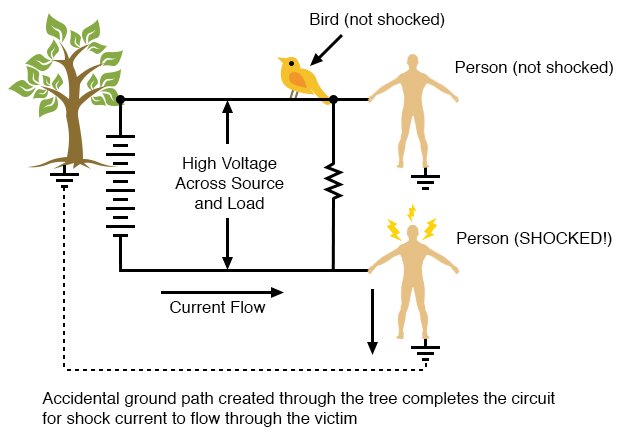I have been thinking about this and I know that other people have answered this on here, but there's one part that still baffles me, and it has to do with parallel circuits.
If I connect a battery to a resistor, and connect another in parallel to it, and measure the current across both, there will be a current! That is, if I connect a $6\ \mathrm V$ battery to a $100\ \mathrm\Omega$ resistor ($R_1$) and connect a $200\ \mathrm\Omega$ resistor in parallel to it ($R_2$), I would still measure $6\ \mathrm V$ across both (voltage is preserved in parallel circuits, correct?) and my current (per Ohm's Law) is
$$I=\frac VR\Rightarrow I=\frac{6\ \mathrm V}{100\ \mathrm\Omega}=0.06\ \mathrm A $$
$$I=\frac VR\Rightarrow I=\frac{6\ \mathrm V}{200\ \mathrm\Omega}=0.03\ \mathrm A $$
So that means one resistor has $6o\ \mathrm{mA}$ and the other has $30\ \mathrm{mA}$. Well and good, but why doesn't this apply to a bird?
That is, a bird dropping its feet on a wire isn't completing a circuit between two different potentials but it is making a parallel circuit. This is what confuses a lot of people I think including me. If the usual laws for parallel circuits apply, why doesn't it apply to birds on a wire?
One explanation I hear is that birds aren't connecting two places of differing potential – but if that was the case then why does my parallel circuit work? One resistor should register no current (or very little) – and I know if I make the resistor large enough (the one in parallel, say, $R_2$) the current draw will be smaller. Is that what is happening? The resistance of the bird is large enough that the current drawn is small?
Let's say a bird has $1\ \mathrm{M\Omega}$ of resistance. A $600\ \mathrm V$ wire would still put $0.6\ \mathrm{mA}$ through the animal.
But that doesn't satisfy me because we are dealing with a $\mathrm{kV}$ scale wire a lot of the time. You'd need for the bird, which is effectively a bag of water and such, to have a lot of resistance for that to work, but maybe it does.
I am always reading that in order for the circuit to be complete the bird (or person) must be grounded, but that doesn't make sense to me because then no parallel circuit would work from batteries! Or even the house current, which is basically a lot of circuits in parallel.
I feel like I am missing something here, and if anyone can tell me what it is that would be greatly appreciated.





